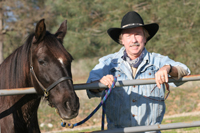Fungal damage is the preliminary cause of serious hoof problems.
“No hoof, no horse” is the motto of the American Farrier’s Association, and no wonder.
Some horse owners spend countless amounts of money purchasing, boarding, feeding, and training their horses, only to find all of their efforts thwarted by poor hoof material. There are many reasons for poor hoof quality:
- Domesticated horses are bred for size, color, speed, gait, and even to have a certain look about them before hoof strength is considered.
- It is well known that a high sugar diet has been proven to contribute to the growing issue of poor hoof material.
- Damp and dirty stall or paddock conditions can cause fungus to abide in the crevices and cracks of the sole and wall of the hoof, providing pathways for bacteria into the inner hoof.
Of these, I believe, fungal damage can be the worst. My opinion may be weighted by the times as a working farrier that I witnessed the cavities, just inside the white line, I would need to exfoliate with a modified hoof knife before applying a fungicide.
I have found that the best way to combat this situation is with good nutrition. When a horse receives the benefit of a good chlorophyll-based diet such as permanent pasture or one of the other organically grown green foods now on the market, cavities fill, over time, with a clear plastic-like material.
Providing healthy hoof material at the distal zone through good nutrition is the best defense against fungal damage.
Wayne Blevins was a working farrier, breeder, trainer, and all around horseman for over 30 years. In the last ten years as a full-time working farrier, Wayne documented the results of feeding E3 AFA FOR HORSES to horses with poor hoof conditions. He now lives in Placerville, California with his wife Jeannie, working to make THE PERFECT HORSE® well known among horsemen worldwide. ThePerfectHorse.net









